The 1888 Indian Head Penny is renowned for its significant mint errors, which substantially increase its value. Even without these errors, pristine Indian Head Cents are highly prized due to their age, being well over a century old.
Indian Head Pennies are not only valuable investments but also cherished by collectors. Let’s delve into the value of the 1888 Indian Head Penny.
Table of Contents
- Value Chart of 1888 Indian Head Penny [Business Strike]
- Value Chart of 1888 Indian Head Penny [Proof]
- Historical Significance of the 1888 Indian Head Penny
- Design of the 1888 Indian Head Penny
- Grading Guide for 1888 Indian Head Penny
- 1888 Indian Head Penny Value Guides
- Rare 1888 Indian Head Penny Error List
- Where to Sell Your 1888 Indian Head penny?
- What to look for in 1888 Indian Head penny?
- FAQs on 1888 Indian Head Penny
- Final Thoughts
Value Chart of 1888 Indian Head Penny [Business Strike]
| Coin | MS 60 | MS 63 | MS 65 | MS 66 | MS 66+ | MS 67 |
|---|---|---|---|---|---|---|
| 1888 Indian Head Penny (Brown) | $120 | $215 | $600 | NA | NA | NA |
| 1888 Indian Head Penny (Red-Brown) | $120 | $250 | $1,300 | $2,250 | NA | NA |
| 1888 Indian Head Penny (Red) | $130 | $325 | $1,750 | $10,500 | $12,500 | $27,500 |
Value Chart of 1888 Indian Head Penny [Proof]
| Coin | PR/PF 60 | PR/PF 62+ | PR/PF 63+ | PR/PF 65 | PR/PF 66 | PR/PF67 |
|---|---|---|---|---|---|---|
| 1888 Proof Indian Head Penny (Brown) | $135 | $260 | $365 | $775 | $1,200 | $2,650 |
| 1888 Proof Indian Head Penny (Red-Brown) | $175 | $325 | $390 | $800 | $2,800 | NA |
| 1888 Proof Indian Head Penny (Red) | $250 | $340 | $650 | $3,350 | $9,000 | NA |
| 1888 Proof Indian Head Penny (Cameo) | NA | NA | $2,500 | $7,150 | $11,500 | NA |
Historical Significance of the 1888 Indian Head Penny
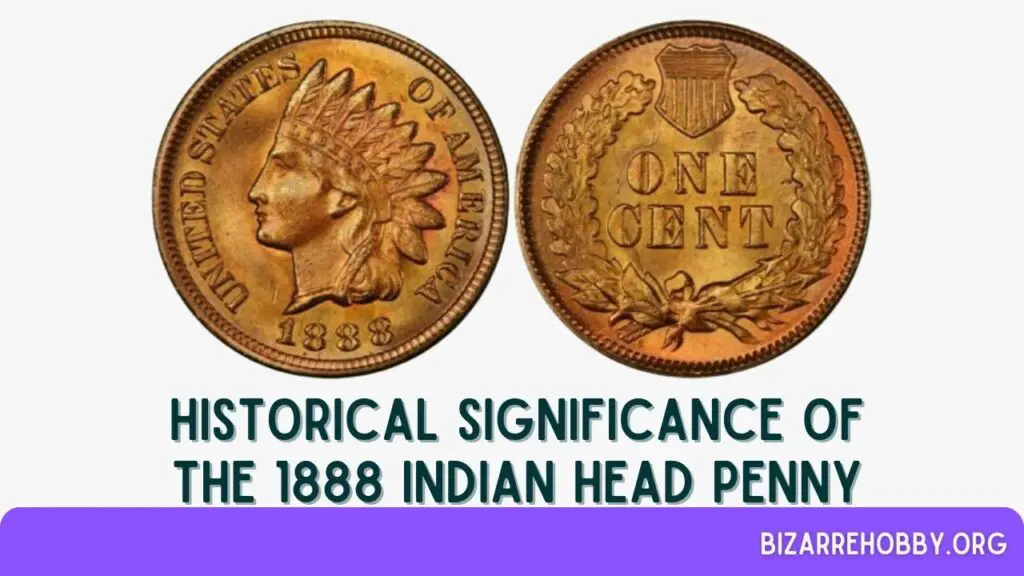
The technology behind coin minting has evolved, but the fundamental techniques remain consistent. While machinery has made the process more efficient, the designs of coins have adapted to reflect changing cultural tastes. As American identity grew distinct from English influences, there was a desire for coins that resonated more with American values.
This led to the creation of the Indian Head Penny, which today might be more accurately called the Native American Head Penny. Chief Mint Engraver James Barton Longacre proposed using Indigenous American imagery. Prior to this, Phrygian caps, symbols of freedom worn by freed slaves, were common on American currency.
the Feathered Headdress & The Story Behind It
Longacre believed that the true American spirit was best represented by Native Americans. There’s a tale that he sketched a Native American Chief who visited his office, though details are unclear.
Another version suggests his daughter Sarah wore the chief’s headdress, which he then drew. Regardless of the exact story, it’s clear Longacre intended to honor Native Americans.
Instead of depicting an actual Native American, Longacre sculpted Lady Liberty adorned with pearls, a Liberty headband, and a Native American Chief’s headdress, which he referred to as a feathered tiara. This design led to the coin being nicknamed the Indian Head Penny.
Indigenous Inspiration for American Coins
The Indian Head Penny was the second design for the smaller penny, introduced in 1856 to reduce the coin’s size from 28.5mm to 19.05mm due to rising copper prices. The first design, the Flying Eagle Cent, was unpopular, necessitating a redesign.
Longacre had previously incorporated Native American motifs in the Indian Princess Gold $1 and $3 coins. These coins featured Lady Liberty with a female headdress, whereas the penny depicted a more masculine headdress. All these designs were inspired by the classical Crouching Venus.
Design of the 1888 Indian Head Penny
In numismatic terms, the heads side of a coin is the obverse, the tails side is the reverse, the thin side is the edge, and the raised border is the collar or rim. The images are devices, the words are legends or mottos, and the background is the field. The blank discs used to make coins are called planchets.
Obverse Design of 1888 Indian Head Penny
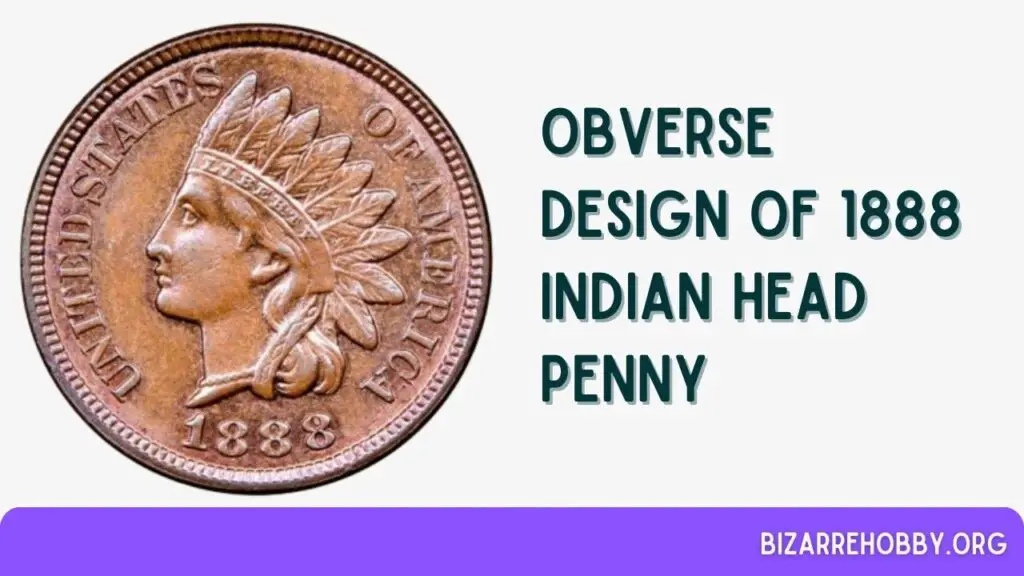
The obverse features Lady Liberty with pearls and a feathered tiara. The word “Liberty” is inscribed on her headband. A small “L” for Longacre is hidden in her hair, near the last feather. “United States” is in front of her face, “Of America” is behind, and the date is below her neck. The coin has denticles or beading around the edge to maintain its shape.
Reverse Design of 1888 Indian Head Penny

The reverse displays a wreath made of oak and laurel, tied with a ribbon that holds three arrows, symbolizing the first three Union States. A shield sits at the top of the wreath. The denomination “One Cent” is in the center. Like the obverse, the reverse has denticles to enhance durability.
Technical Specifications of 1888 Indian Head Penny
1888 Indian head pennies are composed of 95% copper and 5% tin and zinc. They are color-graded as BN (brown), RB (red-brown), or RD (red), with red coins being the most valuable. The 1888 Indian Head Cents measure 19.05mm in diameter, 1.52mm in thickness, and weigh 3.11g. Their edges are plain, without reeds.
Grading Guide for 1888 Indian Head Penny
Indian Head Pennies, initially made of pure copper, evolved in composition over the years. By 1856, they included 12% nickel, and from 1864, they were composed of 5% zinc and tin. This variation in materials results in a range of colors from bright brass to muted brown, leading to the BN (Brown), RB (Red-Brown), and RD (Red) color designations. These coins are graded on the Sheldon Scale, which ranges from 1 to 70.
To accurately determine the value of your coin, refer to our detailed grading guide for Indian Head Penny. Knowing your coin’s grade is essential for assessing its true worth.
| Sheldon Scale | Grade |
|---|---|
| 1 | Basal State-1 |
| 2 | Fair |
| 3 | Very Fair |
| 4, 5, 6 | Good |
| 7, 8, 10 | Very Good |
| 12, 15 | Fine |
| 20, 30 | Very Fine |
| 40 | Extremely Fine |
| 50 | About Uncirculated |
| 60 | Mint State |
| 65 | Mint State |
| 70 | Mint State |
1888 Indian Head Penny Value Guides
In 1888, all Indian Head Pennies were minted in Philadelphia, and none bear a mint mark. This includes both regular and proof coins. Proof coins, crafted for collectors, showcase the ideal coin design and are often archived.
These coins are produced using high-quality dies treated with acid, giving the coin’s design a frosted appearance while the background remains reflective.
The process involves scrubbing the dies with horsehair brushes and tumbling the planchets with stainless steel beads for extra shine. Modern proof coins achieve their frosted look through laser technology, but historically, the acid-pickling method caused the frosted texture to diminish with each strike.
The first 50 to 100 coins struck had the most pronounced contrast and were classified as Deep Cameo or Ultra Cameo, while subsequent coins were labeled as Cameo.
1888 Indian Head Penny Value
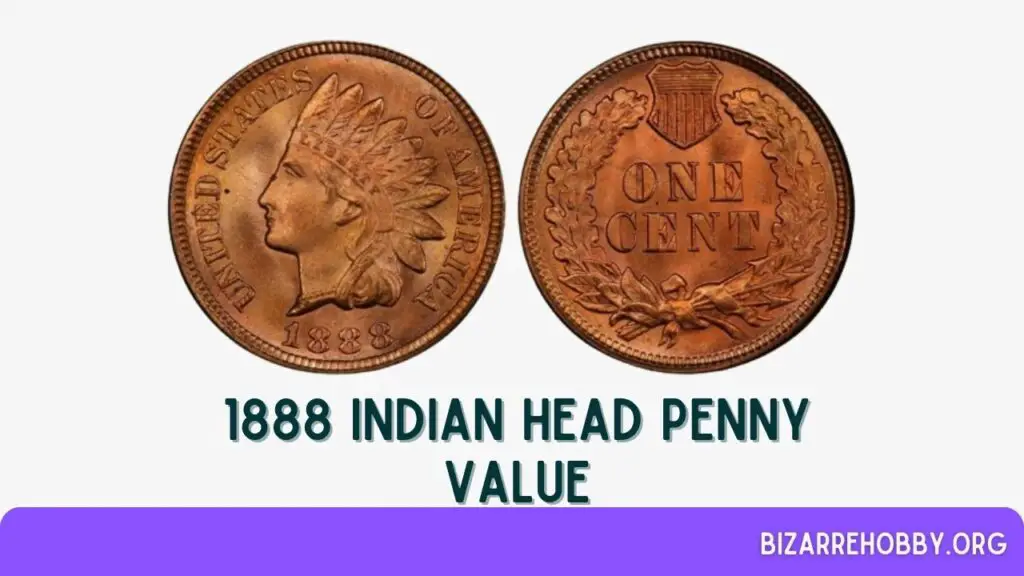
In 1888, the Philadelphia Mint produced 37,489,832 Indian Head Pennies for general circulation. Despite their age, even lower-grade coins can be valuable. For instance, a damaged XF Details coin sold for $932 on eBay in 2019, and a Gem Brilliant Uncirculated coin (around MS 65 BN) fetched $4,600 in 1999.
Brown coins are more common than red ones. Approximately fifteen MS 65 BN coins have been graded by PCGS, with an estimated value of $600 in October 2023. An MS 60 BN is valued at $120.
Reddish-brown coins are rarer; an MS 66 RB sold for $1,880 in January 2017, and PCGS has seen three of these coins, valuing them at $2,250 in October 2023. Over fifty MS 65 RB coins have been graded, with an estimated value of $1,300 in October 2023.
The highest-known grade, an MS 67 RD, sold for $63,250 in July 2003 and is now valued at $27,500. Over thirty MS 65 RD coins are known, valued at $1,750, while an MS 60 RD is worth $130 in October 2023.
1888 Proof Indian Head Penny Value
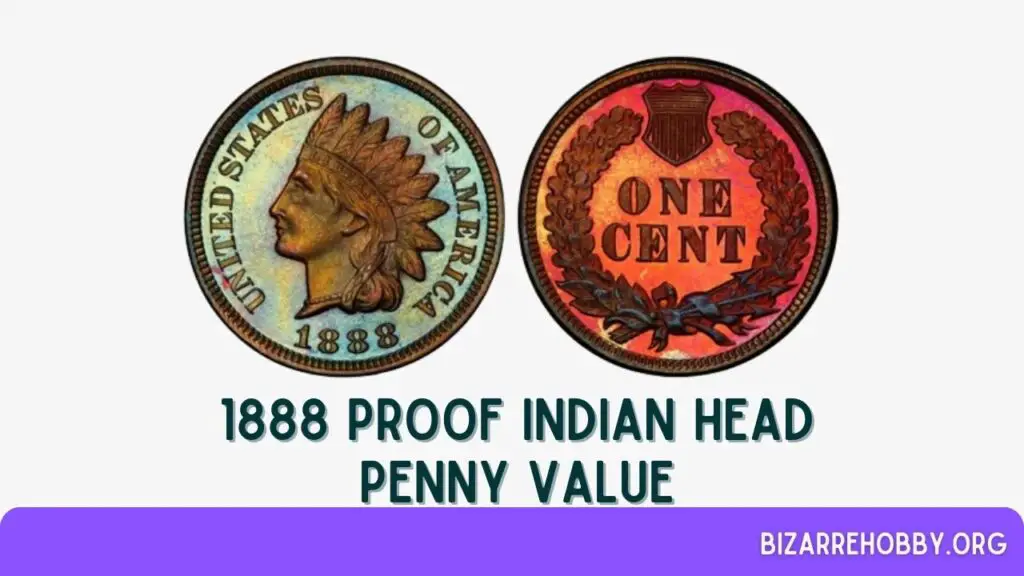
The 1888 Proof Indian Head Pennies, known for their mirror-like finish, were also produced in matte or satin finishes. In 1888, 4,582 proof coins were minted in Philadelphia without mint marks.
A PR 67 BN sold for $3,300 in 1997, but with over a hundred graded by PCGS, their value is $450 in October 2023. Two PR 67 BN coins are valued at $2,650 in 2023.
A PR 66 RB sold for $3,966 in November 2012, with four graded by PCGS, now valued at $2,800 in October 2023. One PR 66+ coin is estimated at $3,500 in 2023.
A PR 66 RD sold for $15,275 in 2014, with four graded by PCGS, now valued at $9,000 in October 2023. A PR 60 RD is worth $250, and a PR 65 RD is valued at $3,350.
Cameo coins are particularly valuable. A PR 66 CAM sold for $18,400 in January 2003, with only two known, now valued at $11,500 in October 2023. A PR 65 CAM is worth $7,150, while a PR 63 CAM is valued at $2,000 in 2023. No PR 60 CAM coins have been reported.
Rare 1888 Indian Head Penny Error List
Mint errors significantly increase a coin’s value, sometimes reaching hundreds or thousands of dollars. Early errors, verified within 30 days of a coin’s release, are known as first-strike (FS) errors.
The most notable FS errors on 1888 Indian Head Cents are RPDs and MPDs. Let’s explore these intriguing mint mistakes.
1888 Indian Penny 8/7 Overdate – FS-301
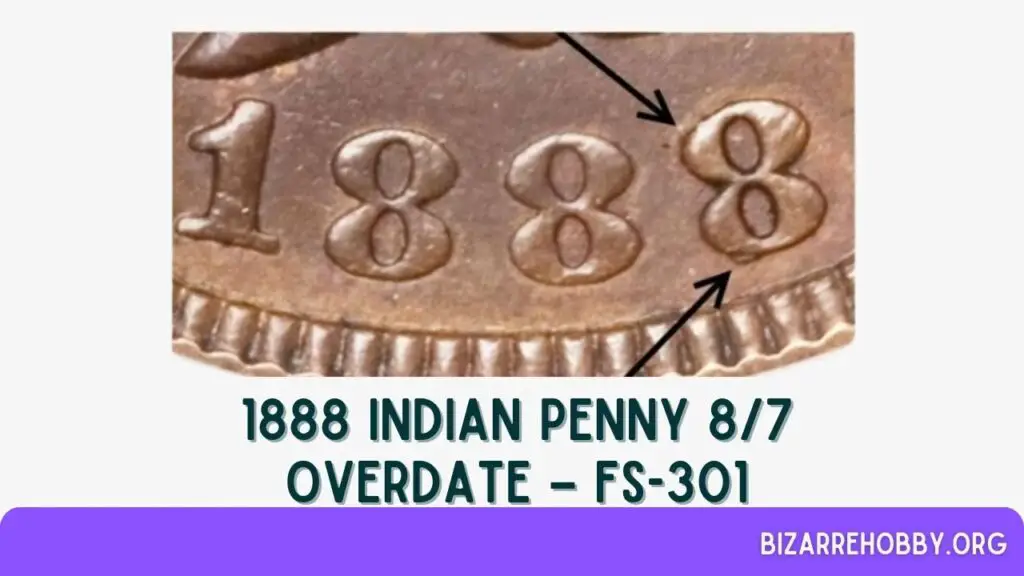
An overdate occurs when one date is struck over another. In this case, 1888 was struck over 1887, with traces of the 7 visible beneath the last 8. This variety error happened at the die stage and was replicated on every coin produced from that die.
An AU 58 BN sold for $43,200 in 2021, an MS 63 BN fetched $74,750 in 2007, and an MS 64 RB was valued at $72,000 in 2019.
1888 Indian Head Penny RPD – FS-302
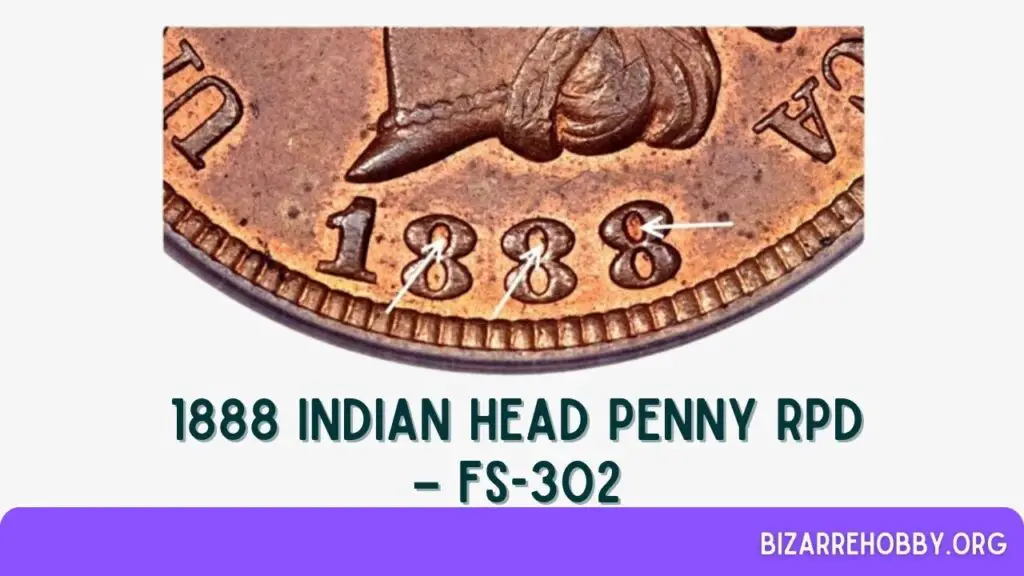
RPD, or re-punched date, occurs when the same date is stamped twice due to a slight movement of the die between strikes. This error, occurring at the die stage, was transferred to all coins produced from that die. An MS 64 BN sold for $9,200 in 2009, and an MS 63 RB was valued at $2,530 in 2011.
1888 Indian Head Penny MPD – FS-303 to FS-305
MPD, or misplaced date, errors on the 1888 Indian Head Penny have three variants: FS-303, FS-304, and FS-305. These errors, occurring at the die stage, involve the misplacement of the 1 and 8. An FS-303 graded G 4 sold for $380 in 2013, and an FS-305 in MS 64 BN was valued at $325 in 2016.
Where to Sell Your 1888 Indian Head penny?
Knowing the value of your 1888 Indian Head Penny is just the first step. To sell your 1888 Indian Head Penny online, check out our list of recommended sites, including their pros and cons.
What to look for in 1888 Indian Head penny?
When examining an 1888 Indian Head Penny, several key factors can significantly impact its value:
- Condition and Grade: The coin’s condition is paramount. Coins are graded on the Sheldon Scale from 1 to 70, with higher grades indicating better preservation. Look for coins with minimal wear, clear details, and no significant damage.
- Color Designation: The color of the penny can affect its value. Coins are categorized as Brown (BN), Red-Brown (RB), or Red (RD). Red coins are typically more valuable due to their rarity and better preservation.
- Mint Errors: Errors such as overdates (e.g., 1888/7), re-punched dates (RPD), and misplaced dates (MPD) can increase a coin’s value. These errors occurred during the minting process and are sought after by collectors.
- Proof Coins: Proof coins, made with special dies and processes, have a mirror-like finish and are often more valuable. Look for deep cameo or ultra cameo designations, which indicate a strong contrast between the frosted design and the reflective background.
- Historical Significance: Understanding the historical context and rarity of the 1888 Indian Head Penny can also add to its appeal. Coins from this era are a tangible link to the past, making them fascinating collectibles.
FAQs on 1888 Indian Head Penny
How Much is an 1888 Indian Head Penny Worth?
The highest-known grade for 1888 Indian Head Pennies is MS 67 RD, which sold for $63,250 in 2003 but is now valued at $28,500. An 1888 Proof Indian Head Cent graded PR 66 RD was worth $15,275 in 2014 but has dropped to $8,750 in 2023. A PR 66 CAM is valued at $11,500.
Is the 1888 Indian Head Penny Rare?
The 1888 Indian Head Penny is not considered extremely rare, but it does hold significant value, especially in higher grades and with certain mint errors.
Final Thoughts
The 1888 Indian Head Penny is a remarkable piece of numismatic history, offering collectors a glimpse into the past. Whether you’re a seasoned collector or a novice, understanding the factors that influence the value of these coins is crucial.
From grading and color designation to mint errors and proof coins, each aspect plays a role in determining a coin’s worth. By carefully examining these elements, you can make informed decisions and potentially uncover valuable treasures in your collection.
